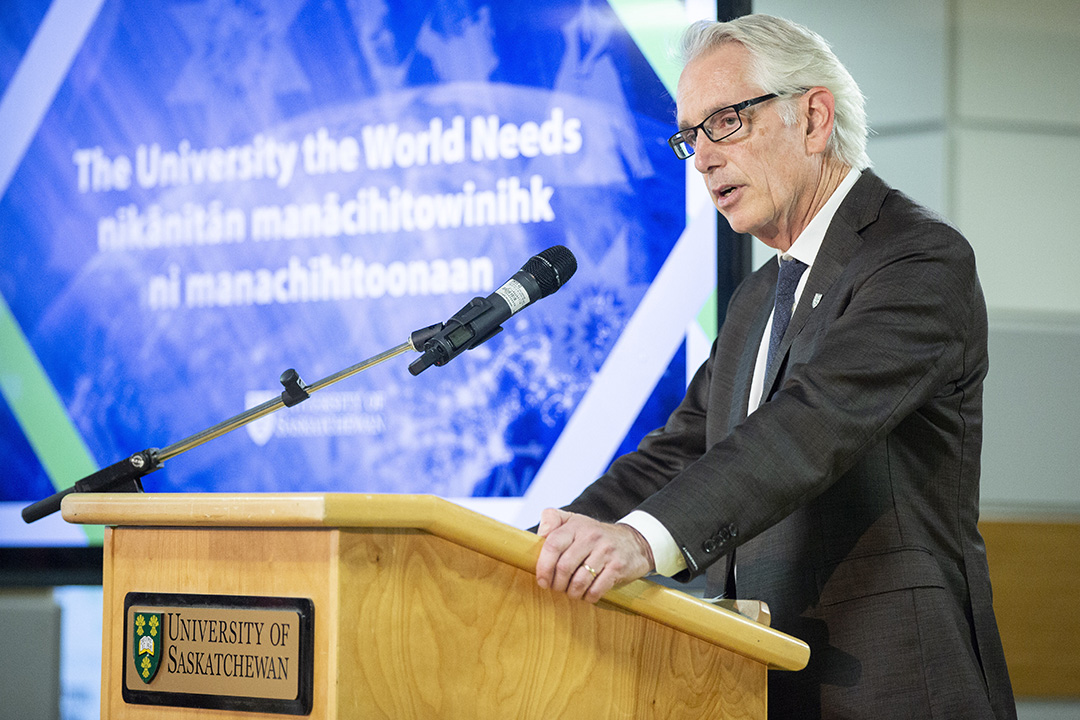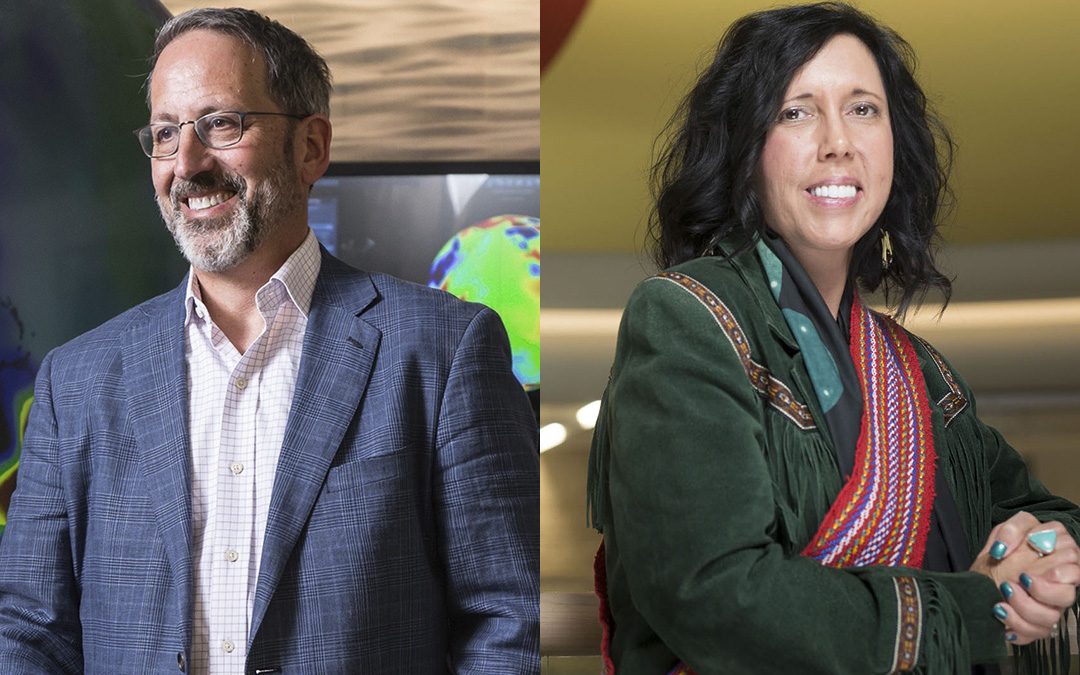
President Stoicheff focused on the future of USask
From opening three major facilities to the launch of a bold new university plan, 2018 marked a major step forward for the University of Saskatchewan. For USask President Peter Stoicheff, the challenge for the university in 2019 is putting that plan into action.
By James Shewaga“You can only plan so much, and the real success is in enacting the plan,” said President Stoicheff, as he sat down with On Campus News to review progress made in 2018 and what lies ahead for the university in 2019. “But I believe that this plan sets us up for success, because the plan evolved naturally and deliberately from the university’s Mission, Vision and Values document that received input from literally thousands of people and was written by a committee that represented many parts of the university.
“So, the plan grew naturally from all of the consultative work that has been done on where the university needs to go. And now we start putting the plan into motion and everybody shares a responsibility for doing that.”
The new integrated strategic plan to carry the institution through to 2025 is titled The University the World Needs, and has been gifted Indigenous names nīkānītān manācihitowinihk (Cree) and ni manachīhitoonaan (Michif), which translate to “Let us lead with respect.” Stoicheff said implementing the progressive plan requires cross-campus commitment.
“Colleges have finished developing their own plans that align with the university-level plan,” said Stoicheff, now in the fourth year of his five-year term as president. “And it’s at the college levels and the unit levels and at the level of the schools that we will see the specific ways in which we can all put the plan into action.”
The Oct. 10 unveiling of the university plan was part of a flurry of fall announcements that included the launch of the $38-million Livestock and Forage Centre of Excellence on Oct. 9 and the $51-million Merlis Belsher Place multisport complex, which opened to the public on Oct. 1 and hosted official grand opening weekend celebrations on Oct. 26-27.
“The opening of the LFCE, the opening of Merlis Belsher Place, and the announcement of the university plan, those were certainly all highlights of the year,” said Stoicheff. “Another highlight I would add to that list is the completion of the ($63-million) Collaborative Science Research Building—completed on time and on budget. It was a year in which three major facilities were completed and opened, as well as the university developing and approving a high-level plan that will take us to 2025. I think each of those is an exciting and bold venture.”
Merlis Belsher Place will also be the site of another major opening in 2019 when the Ron and Jane Graham Sport Science and Health Centre is completed later this year, further enhancing a state-of-the-art complex that features two ice surfaces and two basketball courts.
“All of those features make Merlis Belsher Place more than just a hockey arena, which is what Rutherford Rink was,” said Stoicheff. “We have a community rink as well as the Huskies rink, and we have the Ron and Jane Graham Centre that is designed to take advantage of the unique strengths that we have across all of the health sciences and their relation to sport and sports injuries and recovery. It is an exceptional facility for our campus and for the community.”
The completion of Merlis Belsher Place will also allow convocation ceremonies to return to campus for the first time in 50 years, with the main arena capacity of 3,700 perfect for graduation events.
“Bringing convocation back to campus at Merlis Belsher Place is a very big decision for us and brings together the entire convocation community, college by college, across the eight ceremonies, with all events on campus,” said Stoicheff. “We are delighted that we now have the capacity for it at Merlis Belsher Place.”
In 2018, the university celebrated the centennial of the Edwards School of Business, as well as the 50th anniversary of the College of Dentistry and the College of Arts and Science departments of computer science, archaeology and anthropology, regional and urban planning, and international studies. Meanwhile, the Edwards school, the College of Medicine, and the Western College of Veterinary Medicine all received full accreditation following comprehensive reviews.
Among major research developments in 2018, USask scientists led a breakthrough in agriculture by helping crack the sequencing of the wheat genome, a major step in increasing wheat productivity and improving global food security. This year, USask researchers will look to contribute to Canada’s major agricultural supercluster—Protein Industries Canada—one of five national research superclusters awarded a total of $950-million in federal funding.
“The Protein Industries Canada supercluster is very important to us,” said Stoicheff. “It is industry-led, but by far the greatest research strength is provided by the University of Saskatchewan, historically and also in terms of the future. And our crucial contribution to helping map the wheat genome is but one example of the kind of strength that we bring.”

In 2018, the university also continued to attract top researchers from across the country and around the world, from former NASA scientist Dr. Jay Famiglietti (PhD) taking over as the new executive director of the Global Institute for Water Security, to Dr. Carrie Bourassa (PhD) leading USask’s new Institute of Indigenous Peoples’ Health.
Bourassa joined Cameco Chair in Indigenous Health Dr. Alexandra King (MD) on the growing team of leading Indigenous health researchers across campus.
“It’s terrific having Dr. Bourassa here and having her bring her whole operation here, because Saskatchewan is a province that needs her kind of leadership,” said Stoicheff. “Our ability to attract great talent from beyond Saskatoon and Saskatchewan, and also from beyond Canada, speaks to the fact that we are recognized as having world-class expertise in specific areas and productive researchers want to be a part of that.
“Our researchers want to have an impact on the things that the world needs and the challenges that the world needs solved. By attracting these people, we are able to help provide local solutions to global issues.”
The university is also continuing to attract more students each year, with projected enrolment numbers for the full 2018/19 academic year expected to hit the 25,000 mark. While universities in some Canadian regions are experiencing a decline in enrolment, Stoicheff said he is pleased with USask’s continued growth.
“We have seen increases to our enrolment over at least the last three years and this year we are predicting a larger increase than usual, bringing us close to 25,000 students,” he said. “Our challenge is structuring our enrolment for where we want to get more students from. Is it domestically and locally? Is it out of province, but in Canada? Is it internationally? And of course, supporting Indigenous students—attracting, enrolling and graduating more Indigenous students—is always one of our priorities, as we continue the process of Indigenization and Reconciliation.
“Increasingly, we want to be open to the concept of ‘upscaling’ or life-long learning, recognizing that we have a role to play in helping to educate people whose jobs are changing as a result of a disruptive digital economy.”
One thing that hasn’t changed for the university is the recent budget challenges, specifically provincial funding during the economic downturn in some sectors. However, in addition to the university’s critical role in educating and training the workforce of the future, Stoicheff believes the province appreciates the university’s economic impact ($1.2 billion annually) and return on investment.
“Those budget challenges are always there and no matter what year or what decade in the future, those challenges will always be there,” said Stoicheff. “But I also have the confidence that our provincial government understands the value that the University of Saskatchewan brings to the overall provincial economy, knowing that we have the greatest economic impact per capita in our region of all universities in the country.”
The president said the province has also been a strong supporter of the university’s innovative plan to complete critical infrastructure renewal needed across campus by approving plans for an $85-million bond.
“I believe that we are handling our infrastructure challenges very well and the government has helped us out by approving our ability to issue a bond to finance projects, which is a very innovative way that a few universities across the country have used to meet infrastructure challenges,” said Stoicheff. “I am very confident, given everything that I am seeing, that we will be able to meet those challenges.”
Stoicheff also noted that the success of the fundraising campaign to build Merlis Belsher Place shows that USask alumni and donors are strong supporters of university fundraising projects.
“In terms of funding, we’re such a diverse university with such a strong alumni base of well over 150,000 people around the world, and the success of Merlis Belsher Place gives me the confidence that we have a number of strategies for being financially sustainable,” said Stoicheff.
“I am also going from college to college now thanking them for the hard work that they were asked to do and succeeded in doing, in the wake of a difficult budget one and a half years ago,” the president added. “And one of the things that I am saying to the colleges when I visit them is that everybody at the university continued to think big—despite the economic challenges—which I think reflects the excellence and the boldness of vision that this university has. We are well-positioned to be the university that the world needs.”

